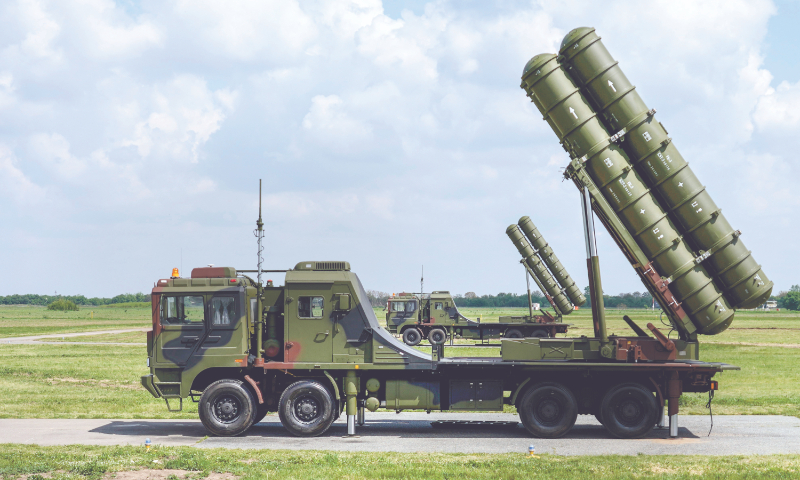
Exclusive: World’s first unit to down stealth aircraft praises new missiles from China after deployment

In 1999, during the NATO aggression on the Federal Republic of Yugoslavia, Serbia’s 250th Air Defense Missile Brigade, then part of the Yugoslav air defense forces, gained global fame by using a second-generation S-125 missile to shoot down a US F-117A stealth aircraft of NATO – the first recorded instance of a stealth aircraft being downed by an air defense missile. Over two decades later, this well-known Serbian unit has again drawn international attention by showcasing its newly acquired Chinese air defense missile systems, at a time when China’s made-for-export equipment such as the J-10CE fighter jet has recently scored outstanding performances in recent foreign combat operations.
What is it like to be equipped with advanced Chinese weaponry? How does Serbia’s 250th Air Defense Missile Brigade, which has an outstanding combat record, view China’s air defense equipment? In a recent exclusive interview with the Global Times, the Commander of the 2 battalion for Air Defense from 250th Air Defense Missile Brigade LTC Dalibor Aleksic shared the “user experience” of China’s air defense weapons from the perspective of actual users.
‘A great honor for us’
In April 2022, reports of six Chinese Air Force Y-20 transport planes landed at Belgrade’s civilian airport reportedly carrying surface-to-air missile systems for the Serbian military sparked global interest.
China’s Foreign Ministry clarified that the delivery was part of “an annually scheduled cooperation project between China and Serbia.”
A year later, Serbia’s Defense Ministry announced that then defense minister Milos Vucevic and then Chinese Ambassador to Serbia Chen Bo visited Serbia’s 250th Air Defense Missile Brigade, now equipped with China’s FK-3 air defense missile system. This public unveiling revived discussions about the brigade’s legendary status, with some Chinese netizens hailing it as a “heroic unit.”
“I would like to emphasize how pleased I am with the fact that in a great country such as the People’s Republic of China, our unit is viewed in a very positive way,” Aleksic told the Global Times. “The 250th Air Defense Missile Brigade was awarded the Order of National Hero for its merits and achieved results during the NATO aggression in 1999, which is the highest recognition that a unit can be awarded. This recognition represents a great honor but also an obligation for us, members of the 250th Air Defense Missile Brigade, to contribute with our work and dedication to preserving the reputation that this brigade enjoys, not only in Serbia but also throughout the world.”
“During our long and rich history, there have been many moments when the Serbian people have shown their fearlessness and have not bowed down to great powers. The shooting down of a stealth aircraft is just one of many examples of the fearlessness of the Serbian people during their rich war history,” Aleksic said.
The US F-117A stealth aircraft was shot down by the Serbian brigade’s Soviet-era S-125 missile, a medium-range system developed in the late 1950s to intercept low-to-medium-altitude aircraft using radio command guidance. The downed US F-117A stealth aircraft was the world’s first stealth aircraft used in actual combat. The case where the 250th Air Defense Missile Brigade used the old S-125 air defense missile to shoot down the US F-117A stealth aircraft is still regarded as a miracle in the history of human aviation.
Aleksic emphasized that studying and learning the characteristics and tactics of using all types of modern air attack weapons is a constant task for members of the units.
“Before the start of the NATO aggression, members of the 250th Air Defense Missile Brigade had a comprehensive approach to training, qualifying to fight against all possible air attack weapons,” said Aleksic. “They, just as we do it today, constantly strived to be highly trained in terms of maximum use of combat capabilities of the S-125 system. Of course, they were familiar with the fact that NATO, in its arsenal, has the most advanced warplane with a minimum radar cross section in the F-117A. In this particular case, their high level of training was only confirmed. The F-117A aircraft for them was just a target in the airspace, like any other target.”
“Regardless of a generational gap in weapons and equipment, through a combination of high-level combat training and the application of superior tactical procedures, they achieved something that no one had managed to do before, because the stealth aircraft F-117A was considered invisible and invincible until that moment,” said Aleksic.
‘Experience from use is very positive’
Since acquiring Chinese systems, Serbia has openly displayed them, with political and military leaders expressing pride in their capabilities. A new acquisition was unveiled for the first time during a military parade in the city of Kruševac on the occasion of the country’s largest religious holiday, the Feast of Vidovdan (also known as St. Vitus Day) in June 2024, local media reported.
During the ceremony, then Serbian Prime Minister Milos Vucevic said that they were to display the recently acquired HQ-17AE short-range anti-aircraft defense system from China, adding that this was the first time these systems had been seen by anyone outside of the relevant units. Vucevic also underscored that HQ-17AE systems would provide even better protection to the Serbian airspace and would perfect pair with the country’s most powerful air defense weapon, the FK-3.
By late 2024, Serbia’s Defense Ministry had highlighted the FK-3 on its website, calling it a “milestone in air defense systems.” Captain 1st Class Stefan Manić, the missile battery commander, said, “It is a great honor to be the commander of an air defense missile battery and to work on the most powerful air defense missile system that our country has.”
“By arming the Air Force and Air Defense with the new FK-3 air defense missile system, the airspace control and protection system has been significantly improved in the Republic of Serbia,” the Serbian Ministry of Defense said in a statement. The statement also noted that the system comprises a command center vehicle, rocket launchers, radars, and logistics support vehicles.
As a “user” of these two types of air defense missile weapon systems, Aleksic emphasized that the experiences from the use of the FK-3 and HQ-17AE air defense systems “are very positive so far,” adding that the unit is satisfied with their combat capabilities, performance, reliability, and ease of use and maintenance.
“On this occasion, I would also like to highlight the exceptional cooperation withthe representatives of the manufacturers, who were always ready to meet our needs and further adapt these air defense systems to our needs. The acquisition of these two air defense systems contributed to the further strengthening of friendship and cooperation between the Republic of Serbia and China,” said Aleksic.
According to reports, the FK-3, unveiled at Airshow China 2014 for the first time, is an all-weather, medium-to-long-range air defense system designed for regional and field defense. It can intercept fixed-wing aircraft, drones, cruise missiles, tactical air-to-ground missiles, and armed helicopters, boasting strong anti-jamming capabilities and combat efficiency. With a four-missile canister launcher, it offers 360-degree interception, rapid response, and the ability to engage highly maneuverable targets.
The system is capable of engaging a variety of aerial threats, including aircraft, helicopters, cruise missiles, and air-to-surface missiles at speeds of 1,000 meters per second, with a range of up to 100 kilometers in distance, 27 kilometers in altitude. The FK-3 protects key infrastructure and territory from aerial threats, reinforcing Serbia’s sovereignty, according to the official website of Serbian Defense Ministry.
“The introduction of this FK-3 system into the armament of the Serbian Armed Forces represents an improvement in the air defense system in every sense. The capabilities of protecting the airspace of the Republic of Serbia have been improved by significantly increasing the distance of reliable detection and tracking of targets, the interception zone, the number of available targeting channels, and the probability of destroying targets, among others,” Aleksic explained, adding that “a large part of the integration of the FK-3 air defense system into the air defense system of the Republic of Serbia was done even before delivery, and during the final qualitative and quantitative acceptance, the integration was fully implemented. The FK-3 air defense system is fully integrated into the command system, which also ensures the necessary integration with other modern combat assets in the air defense system.”
Another Chinese-developed short-range air defense missile weapon system introduced by Serbia, the HQ-17AE, is known as the “low-altitude hunter.” The combat vehicle of this weapon system is highly integrated and can operate independently, with the capabilities of target search, tracking, and missile launch while moving. Its combat altitude ranges from 10 meters to 12 kilometers. A single combat vehicle can guide 4 missiles simultaneously to intercept 4 targets, demonstrating excellent missile mobility and strong multi-target engagement capabilities.
“Equipping the Serbian Armed Forces with the FK-3 and HQ-17AE air defense systems primarily improved the efficiency of the organization of the air warning system, which has proven to be one of the decisive factors for achieving success in modern conflicts. It also improved the capability to protect our own forces and all important facilities in the territory against all types of air attack weapons, over a wide range of distances and heights, with operations carried out both statically and while in motion,” said Aleksic.
‘HQ-19 anti-ballistic missile weapon system fascinates me the most’
Recently, due to the remarkable performance of China’s made-for-export J-10CE fighter jets in foreign air combat operations, Chinese weaponry has sparked a “China craze” at major international defense exhibitions. Chinese export-oriented weapon systems, including the J-10CE, FK-3 air defense missile system, and HQ-17AE short-range air defense missile system, have become hot topics in global media due to their superior performance.
In the view of Aleksic, China’s military industry is a treasure trove. Apart from the FK-3 and HQ-17AE, there are many other Chinese weapon systems that fascinate him as a weapons expert.
“I follow the new achievements in the development of arms and military equipment in foreign armies, including the arms developed by China, because it is an integral part of my job,” Aleksic stated, adding that if he had to specifically mention some of the achievements that left a deep impression on him, they would undoubtedly be the weapon systems within his sphere of interest. “The weapon system that fascinates me the most is the HQ-19 anti-ballistic missile system.”
He also highlighted the Chinese fifth-generation J-35A fighters, while noting that China also has a wide range of UAVs, with exceptional performance, of which he is particularly fascinated by the Wing Loong 2 and Wing Loong 3 series of UAVs.
“I would also like to refer to the impressive nuclear arsenal of China where great progress has been made in recent years, especially in the development of ballistic missiles. I would particularly highlight the DF series of missiles that cover all ranges, from short-range to intercontinental ballistic missiles, among which the DF-17, DF-31 and DF-41 stand out with their characteristics. In addition to all of the above, the speed with which China is advancing its space program is also impressive,” Aleksic said.
In 1999, during the NATO aggression on the Federal Republic of Yugoslavia, Serbia’s 250th Air Defense Missile Brigade, then part of the Yugoslav air defense forces, gained global fame by using a second-generation S-125 missile to shoot down a US F-117A stealth aircraft of NATO – the first recorded instance of a stealth aircraft being downed by an air defense missile. Over two decades later, this well-known Serbian unit has again drawn international attention by showcasing its newly acquired Chinese air defense missile systems, at a time when China’s made-for-export equipment such as the J-10CE fighter jet has recently scored outstanding performances in recent foreign combat operations.
What is it like to be equipped with advanced Chinese weaponry? How does Serbia’s 250th Air Defense Missile Brigade, which has an outstanding combat record, view China’s air defense equipment? In a recent exclusive interview with the Global Times, the Commander of the 2 battalion for Air Defense from 250th Air Defense Missile Brigade LTC Dalibor Aleksic shared the “user experience” of China’s air defense weapons from the perspective of actual users.
‘A great honor for us’
In April 2022, reports of six Chinese Air Force Y-20 transport planes landed at Belgrade’s civilian airport reportedly carrying surface-to-air missile systems for the Serbian military sparked global interest.
China’s Foreign Ministry clarified that the delivery was part of “an annually scheduled cooperation project between China and Serbia.”
A year later, Serbia’s Defense Ministry announced that then defense minister Milos Vucevic and then Chinese Ambassador to Serbia Chen Bo visited Serbia’s 250th Air Defense Missile Brigade, now equipped with China’s FK-3 air defense missile system. This public unveiling revived discussions about the brigade’s legendary status, with some Chinese netizens hailing it as a “heroic unit.”
“I would like to emphasize how pleased I am with the fact that in a great country such as the People’s Republic of China, our unit is viewed in a very positive way,” Aleksic told the Global Times. “The 250th Air Defense Missile Brigade was awarded the Order of National Hero for its merits and achieved results during the NATO aggression in 1999, which is the highest recognition that a unit can be awarded. This recognition represents a great honor but also an obligation for us, members of the 250th Air Defense Missile Brigade, to contribute with our work and dedication to preserving the reputation that this brigade enjoys, not only in Serbia but also throughout the world.”
“During our long and rich history, there have been many moments when the Serbian people have shown their fearlessness and have not bowed down to great powers. The shooting down of a stealth aircraft is just one of many examples of the fearlessness of the Serbian people during their rich war history,” Aleksic said.
The US F-117A stealth aircraft was shot down by the Serbian brigade’s Soviet-era S-125 missile, a medium-range system developed in the late 1950s to intercept low-to-medium-altitude aircraft using radio command guidance. The downed US F-117A stealth aircraft was the world’s first stealth aircraft used in actual combat. The case where the 250th Air Defense Missile Brigade used the old S-125 air defense missile to shoot down the US F-117A stealth aircraft is still regarded as a miracle in the history of human aviation.
Aleksic emphasized that studying and learning the characteristics and tactics of using all types of modern air attack weapons is a constant task for members of the units.
“Before the start of the NATO aggression, members of the 250th Air Defense Missile Brigade had a comprehensive approach to training, qualifying to fight against all possible air attack weapons,” said Aleksic. “They, just as we do it today, constantly strived to be highly trained in terms of maximum use of combat capabilities of the S-125 system. Of course, they were familiar with the fact that NATO, in its arsenal, has the most advanced warplane with a minimum radar cross section in the F-117A. In this particular case, their high level of training was only confirmed. The F-117A aircraft for them was just a target in the airspace, like any other target.”
“Regardless of a generational gap in weapons and equipment, through a combination of high-level combat training and the application of superior tactical procedures, they achieved something that no one had managed to do before, because the stealth aircraft F-117A was considered invisible and invincible until that moment,” said Aleksic.
‘Experience from use is very positive’
Since acquiring Chinese systems, Serbia has openly displayed them, with political and military leaders expressing pride in their capabilities. A new acquisition was unveiled for the first time during a military parade in the city of Kruševac on the occasion of the country’s largest religious holiday, the Feast of Vidovdan (also known as St. Vitus Day) in June 2024, local media reported.
During the ceremony, then Serbian Prime Minister Milos Vucevic said that they were to display the recently acquired HQ-17AE short-range anti-aircraft defense system from China, adding that this was the first time these systems had been seen by anyone outside of the relevant units. Vucevic also underscored that HQ-17AE systems would provide even better protection to the Serbian airspace and would perfect pair with the country’s most powerful air defense weapon, the FK-3.
By late 2024, Serbia’s Defense Ministry had highlighted the FK-3 on its website, calling it a “milestone in air defense systems.” Captain 1st Class Stefan Manić, the missile battery commander, said, “It is a great honor to be the commander of an air defense missile battery and to work on the most powerful air defense missile system that our country has.”
“By arming the Air Force and Air Defense with the new FK-3 air defense missile system, the airspace control and protection system has been significantly improved in the Republic of Serbia,” the Serbian Ministry of Defense said in a statement. The statement also noted that the system comprises a command center vehicle, rocket launchers, radars, and logistics support vehicles.
As a “user” of these two types of air defense missile weapon systems, Aleksic emphasized that the experiences from the use of the FK-3 and HQ-17AE air defense systems “are very positive so far,” adding that the unit is satisfied with their combat capabilities, performance, reliability, and ease of use and maintenance.
“On this occasion, I would also like to highlight the exceptional cooperation withthe representatives of the manufacturers, who were always ready to meet our needs and further adapt these air defense systems to our needs. The acquisition of these two air defense systems contributed to the further strengthening of friendship and cooperation between the Republic of Serbia and China,” said Aleksic.
According to reports, the FK-3, unveiled at Airshow China 2014 for the first time, is an all-weather, medium-to-long-range air defense system designed for regional and field defense. It can intercept fixed-wing aircraft, drones, cruise missiles, tactical air-to-ground missiles, and armed helicopters, boasting strong anti-jamming capabilities and combat efficiency. With a four-missile canister launcher, it offers 360-degree interception, rapid response, and the ability to engage highly maneuverable targets.
The system is capable of engaging a variety of aerial threats, including aircraft, helicopters, cruise missiles, and air-to-surface missiles at speeds of 1,000 meters per second, with a range of up to 100 kilometers in distance, 27 kilometers in altitude. The FK-3 protects key infrastructure and territory from aerial threats, reinforcing Serbia’s sovereignty, according to the official website of Serbian Defense Ministry.
“The introduction of this FK-3 system into the armament of the Serbian Armed Forces represents an improvement in the air defense system in every sense. The capabilities of protecting the airspace of the Republic of Serbia have been improved by significantly increasing the distance of reliable detection and tracking of targets, the interception zone, the number of available targeting channels, and the probability of destroying targets, among others,” Aleksic explained, adding that “a large part of the integration of the FK-3 air defense system into the air defense system of the Republic of Serbia was done even before delivery, and during the final qualitative and quantitative acceptance, the integration was fully implemented. The FK-3 air defense system is fully integrated into the command system, which also ensures the necessary integration with other modern combat assets in the air defense system.”
Another Chinese-developed short-range air defense missile weapon system introduced by Serbia, the HQ-17AE, is known as the “low-altitude hunter.” The combat vehicle of this weapon system is highly integrated and can operate independently, with the capabilities of target search, tracking, and missile launch while moving. Its combat altitude ranges from 10 meters to 12 kilometers. A single combat vehicle can guide 4 missiles simultaneously to intercept 4 targets, demonstrating excellent missile mobility and strong multi-target engagement capabilities.
“Equipping the Serbian Armed Forces with the FK-3 and HQ-17AE air defense systems primarily improved the efficiency of the organization of the air warning system, which has proven to be one of the decisive factors for achieving success in modern conflicts. It also improved the capability to protect our own forces and all important facilities in the territory against all types of air attack weapons, over a wide range of distances and heights, with operations carried out both statically and while in motion,” said Aleksic.
‘HQ-19 anti-ballistic missile weapon system fascinates me the most’
Recently, due to the remarkable performance of China’s made-for-export J-10CE fighter jets in foreign air combat operations, Chinese weaponry has sparked a “China craze” at major international defense exhibitions. Chinese export-oriented weapon systems, including the J-10CE, FK-3 air defense missile system, and HQ-17AE short-range air defense missile system, have become hot topics in global media due to their superior performance.
In the view of Aleksic, China’s military industry is a treasure trove. Apart from the FK-3 and HQ-17AE, there are many other Chinese weapon systems that fascinate him as a weapons expert.
“I follow the new achievements in the development of arms and military equipment in foreign armies, including the arms developed by China, because it is an integral part of my job,” Aleksic stated, adding that if he had to specifically mention some of the achievements that left a deep impression on him, they would undoubtedly be the weapon systems within his sphere of interest. “The weapon system that fascinates me the most is the HQ-19 anti-ballistic missile system.”
He also highlighted the Chinese fifth-generation J-35A fighters, while noting that China also has a wide range of UAVs, with exceptional performance, of which he is particularly fascinated by the Wing Loong 2 and Wing Loong 3 series of UAVs.
“I would also like to refer to the impressive nuclear arsenal of China where great progress has been made in recent years, especially in the development of ballistic missiles. I would particularly highlight the DF series of missiles that cover all ranges, from short-range to intercontinental ballistic missiles, among which the DF-17, DF-31 and DF-41 stand out with their characteristics. In addition to all of the above, the speed with which China is advancing its space program is also impressive,” Aleksic said.


